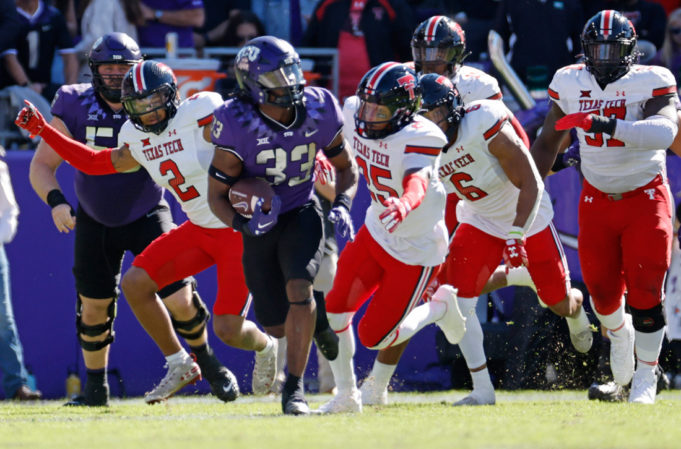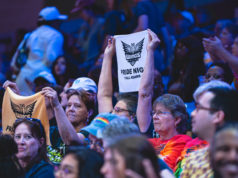Santa Chaos came bombing down the College Football Playoff selection committee’s chimney on Saturday. Clemson was shellacked by an average Notre Dame squad that doesn’t really have a passing attack. LSU’s Chip Kelly solidified his procreation sacks as some of the biggest in the country by going for two in the first overtime to beat Alabama, and Tennessee looked absolutely pedestrian at Georgia as the reigning champs made Rocky Top’s previously prolific offense seem like a scout team of walk-ons. Almost every positive butterfly effect in the college football universe fluttered in favor of the Frogs on Saturday, and now our boys are ranked fourth in the AP after graduating with a degree in besting Tech by beating them for the fourth consecutive time, thanks to 21 fourth-quarter points from Sonny Dykes’ offense, which just couldn’t seem to gain traction until then.
Now that TCU is among just four unbeaten outfits in the country, it’s time for a reality check about what the Frogs are and what they aren’t. I’m not dragging in garbage sacks of doom and gloom, but I want my readership to be the most eloquent and educated, as well as realistic, of college football fanatics. Homers just spout on about how great their teams are, and there are plenty out there. We Frog fans can be better than that.
Most obviously, TCU is a team of veterans who find ways to win games. Quentin Johnston (#1), our beloved deep threat, saw limited action against the Mountaineers and didn’t play any meaningful snaps against Tech. Johnston’s absence was significant, and Tech’s large defensive backs did an admirable job of holding Max Duggan (#15) and company in check for the majority of the game. Still, TCU is one of the most explosive units in the country and has been able to score quickly, regardless of personnel, against everyone they’ve played. Dykes has turbocharged this group that is Top 5 in both scoring and yards per game. The Frogs also have more 50-plus yard plays than anyone in the country.
Conversely, this offense is poor in the red zone and can’t always be trusted to convert short-yardage plays. The Frogs failed all three fourth-down conversions against the Red Raiders, who also failed on three of their six attempts on Saturday. Despite the purple O’s shortcomings, they’re excellent, bordering on elite, based on how fast they can score and how quickly they can pivot from out of rhythm to trotting into the end zone from midfield.
Also, maybe obviously, Joe Gillespie’s defense isn’t great. While improved from last season, TCU’s D ranks at the bottom half of almost every meaningful statistic with the exception of interceptions and passes defended. The puzzling phenomenon is that the Froggie defense is much better after halftime, when they’ve given up 102 total second half points through nine games, just slightly more than 11 per. For context, SMU and Kansas scored 56 of them, so clamping down against conference opponents late hasn’t been an issue. Yet, and rightfully so, the dichotomy of the purple offense and defense is what keeps the Haterade flowing regarding the purple and white being serious playoff contenders, which is fair. Both Michigan and Ohio State are Top 10 in both scoring offense and defense, and Georgia (the other unbeaten) is close.
All the aforementioned considered, TCU’s only play is to continue winning in the most balanced conference in the country, and that means facing Texas and our own founding father, Gary “MFing” Patterson, in Austin for both teams’ second appearance on College Gameday this season. TCU, who has lost only once against the spread this year, is a seven-point road underdog despite facing a team with three actual losses, two against teams the Frogs have already beaten. Patterson-coached Frogs beat UT in seven of the last nine meetings, and the last three games — the most recent of which when Jerry Kill was coaching was won by the burnt orange — have been decided by a combined 17 points. Statistically, the Longhorns are a more balanced squad than TCU, with their offense leading the way and their decent defense trying to defend leads. However, this MO hasn’t proved successful, as the capital dwellers have become one of the best in the nation at blowing double-digit advantages. Come to think of it, TCU might be the best team in the country at clawing themselves out of an early hole. However, it would be in Dykes’ and every purple fan’s interest if the Frogs played four complete quarters. Their performances in Morgantown and against Tech probably won’t cut it against the Longhorns. Patterson, naturally, will be looking to show the TCU athletic administration they made a mistake by ousting him before he was ready, though beating Dykes is something he’s yet to be able to do.
Johnston’s availability — even if only limited — could be a huge factor. Also, Dee Winters (#13), TCU’s best linebacker, will have to sit out for the first half because of a second-half targeting call against a Tech receiver. The Frogs have the advantage of possessing the only elite unit on the field, but can their overpowering offense, combined with a below-average defense, beat Texas’ good offense and average defense? These squads tend to play close games, but I’d bet on the experience of the undefeated squad and their quarterback who has already beaten UT twice during his career.












